brake Lexus IS250 2009 Do-it-yourself maintenance / LEXUS 2009 IS350/250 QUICK GUIDE OWNER'S MANUAL (OM53689U)
[x] Cancel search | Manufacturer: LEXUS, Model Year: 2009, Model line: IS250, Model: Lexus IS250 2009Pages: 66, PDF Size: 2.47 MB
Page 1 of 66
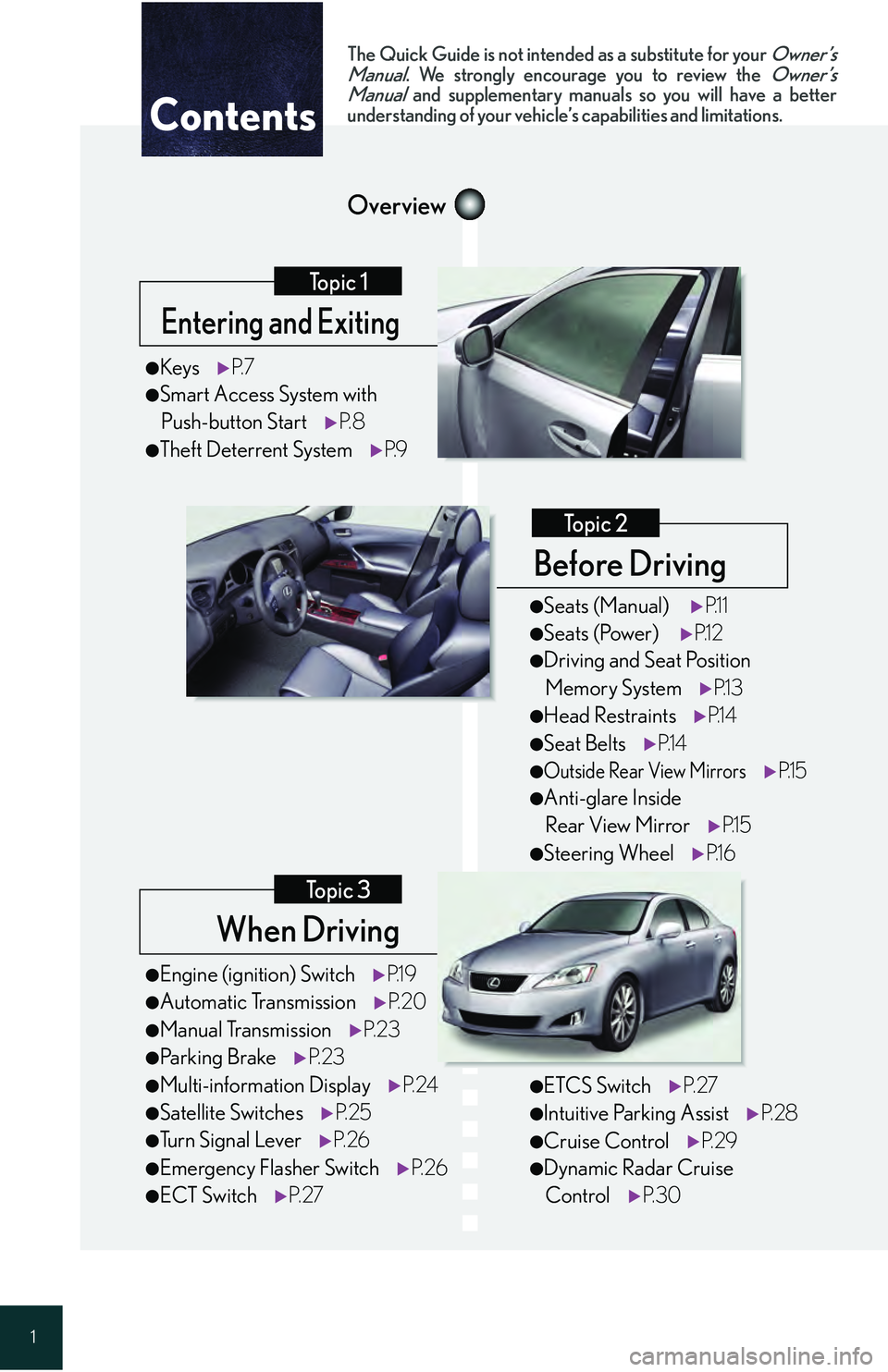
1
When Driving
Topic 3
Entering and Exiting
Topic 1
Before Driving
Topic 2
Overview
Contents
â—ŹEngine (ignition) SwitchP.1 9
â—ŹAutomatic Transmission P. 2 0
â—ŹManual TransmissionP. 2 3
â—ŹParking BrakeP. 2 3
â—ŹMulti-information Display P. 2 4
â—ŹSatellite SwitchesP. 2 5
â—ŹTu r n S i g n a l L e v e rP. 2 6
â—ŹEmergency Flasher Switch P. 2 6
â—ŹECT SwitchP. 2 7
â—ŹKeysP. 7
â—ŹSmart Access System with
Push-button Start P. 8
â—ŹTheft Deterrent System P.9
The Quick Guide is not intended as a substitute for your Owner’s
Manual. We strongly encourage you to review the Owner’s
Manual and supplementary manuals so you will have a better
understanding of your vehicle’ s capabilities and limitations.
â—ŹETCS SwitchP. 2 7
â—ŹIntuitive Parking Assist P. 2 8
â—ŹCruise ControlP. 2 9
â—ŹDynamic Radar Cruise
Control P. 3 0
â—ŹSeats (Manual) P.1 1
â—ŹSeats (Power) P.1 2
â—ŹDriving and Seat Position
Memory System P.1 3
â—ŹHead RestraintsP.1 4
â—ŹSeat BeltsP.1 4
â—ŹOutside Rear View MirrorsP.1 5
â—ŹAnti-glare Inside
Rear View Mirror P.1 5
â—ŹSteering WheelP.1 6
Page 3 of 66

3
OverviewInstrument Panel
Shift paddle switches (automatic transmission)
P.20
Headlight switch
Turn signal lever Fog light switch P.33
P.26
P.34
Headlight cleaner switch  P.37
Rear sunshade switch  P.49
Inside door lock button P.53
Fuel filler door opener P.55
Driving and seat position
memory switches
 P.13
Power window switches P.54
Window lock switch P.54
Outside rear view
mirror switches
P.15
Trunk opener P.56
Hood release lever P.55
Parking brake pedal
(automatic transmission)
P.23
Satellite switches P.25
Tilt and telescopic steering lock release lever
 P.16Tilt and telesc opic steering
control switch
 P.16
Multi-information
display
P.24
Door lock switches P.53
Page 5 of 66
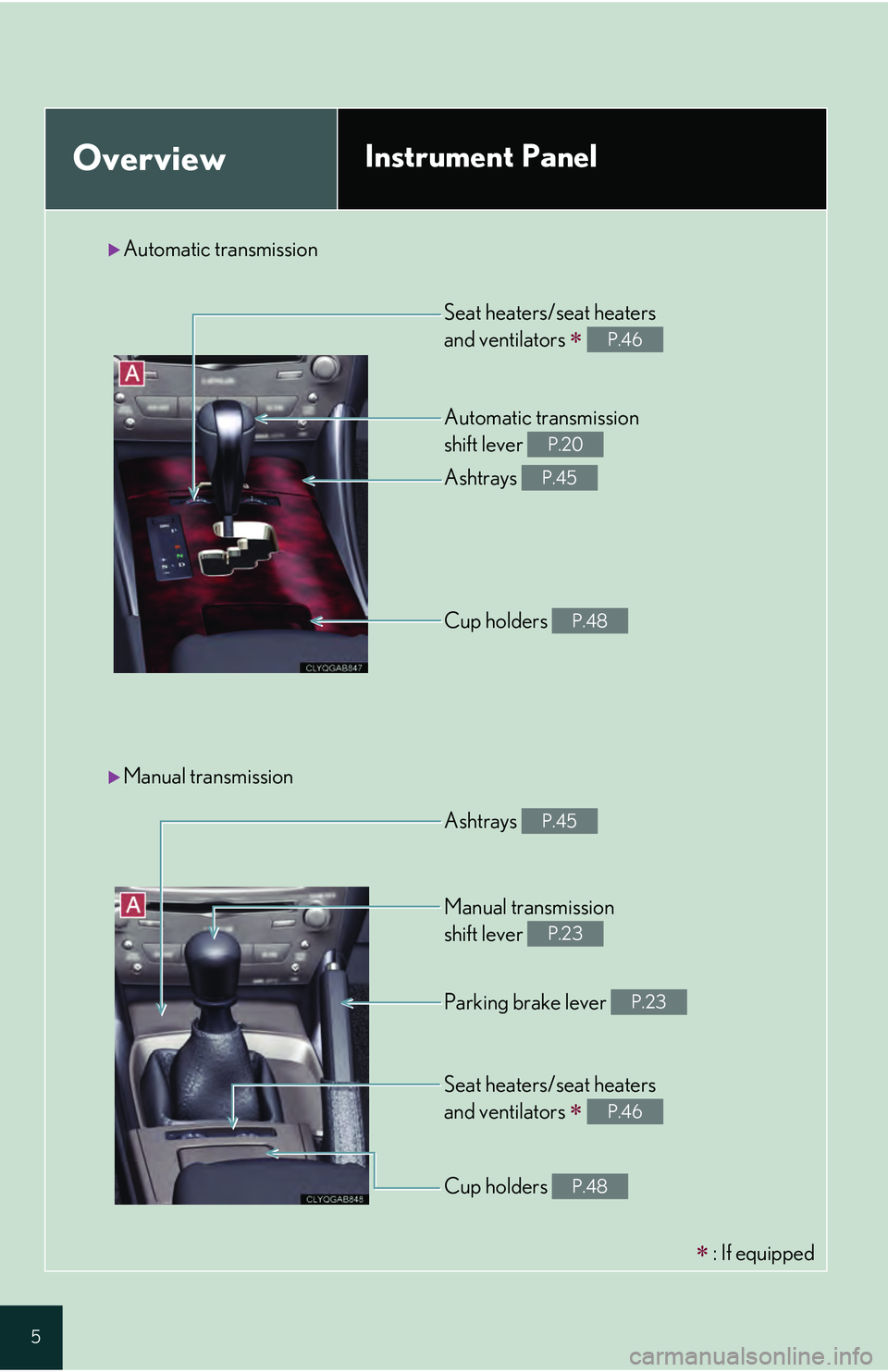
5
OverviewInstrument Panel
Seat heaters/seat heaters
and ventilators
 P.46
Automatic transmission
shift lever
P.20
Ashtrays P.45
Cup holders P.48
Ashtrays P.45
Manual transmission
shift lever
P.23
Parking brake lever P.23
Seat heaters/seat heaters
and ventilators
 P.46
Cup holders P.48
Automatic transmission
Manual transmission
 : If equipped
Page 18 of 66
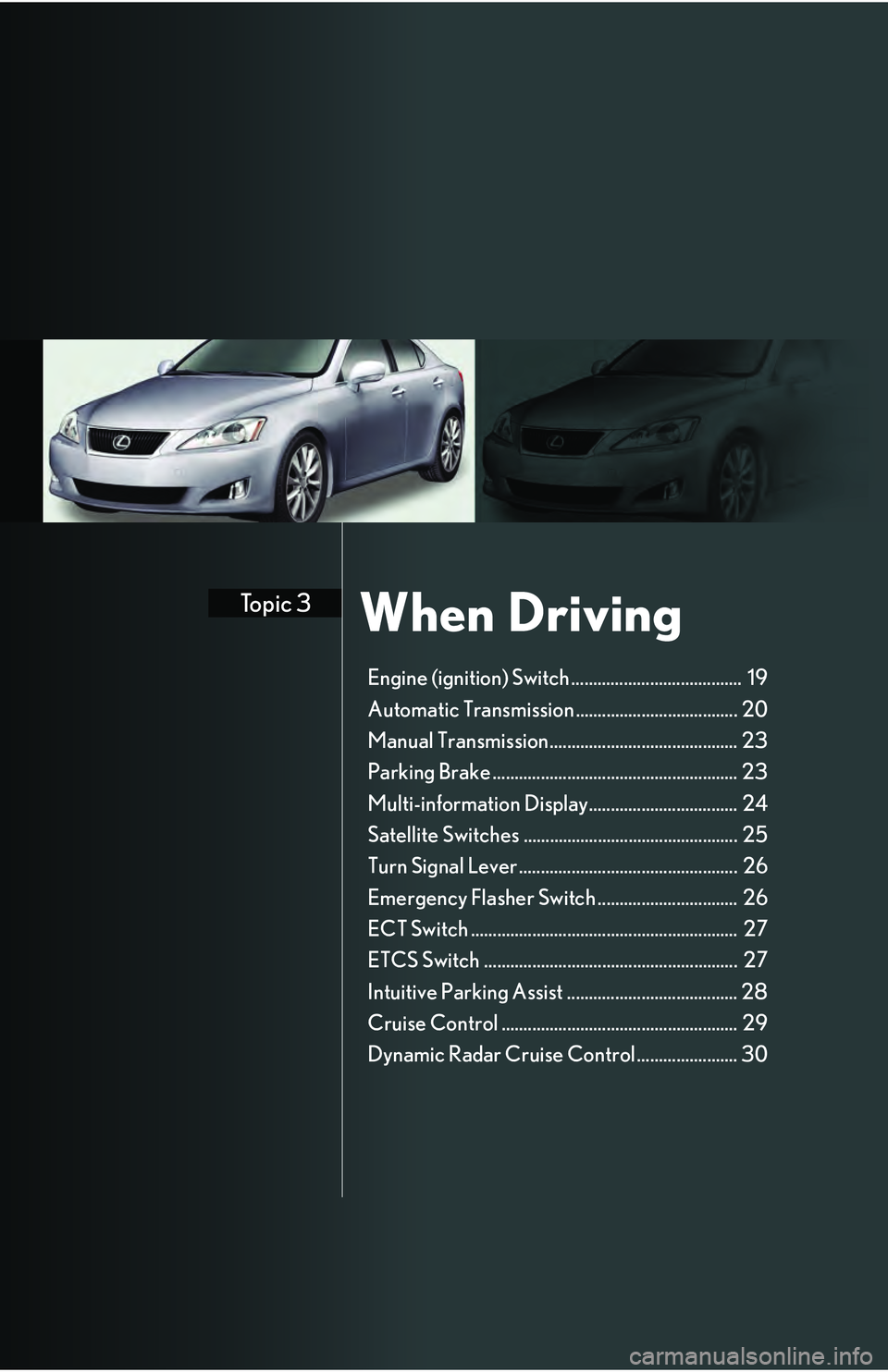
When DrivingTopic 3
Engine (ignition) Switch ....................................... 19
Automatic Transmission ..................................... 20
Manual Transmission........................................... 23
Parking Brake ........................................................ 23
Multi-information Display.................................. 24
Satellite Switches ................................................. 25
Turn Signal Lever .................................................. 26
Emergency Flasher Switch ................................ 26
ECT Switch ............................................................. 27
ETCS Switch .......................................................... 27
Intuitive Parking Assist ....................................... 28
Cruise Control ...................................................... 29
Dynamic Radar Cruise Control....................... 30
Page 19 of 66

Topic 3
When Driving
19
Engine (ignition) Switch
â– Starting the engine
Automatic transmission
Make sure the parking brake is engaged and the
shift lever is in P.
Depress the brake pedal.The “ENGINE START STOP” switch indi-
cator light turns green.
Press the “ENGINE START STOP” switch.
Manual transmission
Make sure the parking brake is engaged and the
shift lever is in N.
Depress the clutch pedal.The “ENGINE START STOP” switch indi-
cator light turns green.
Press the “ENGINE START STOP” switch.
â– Stopping the engine
Engage the parking brake and shift the shift lever to P (for automatic transmission) or N
(for manual transmission).
Press the “ENGINE START STOP” switch.
With the electronic key on your person, the engine can be started by simply pressing the
“ENGINE START STOP” switch, while depressing the brake pedal or clutch pedal.
(The mechanical key cannot be used to start the engine.)
Page 20 of 66
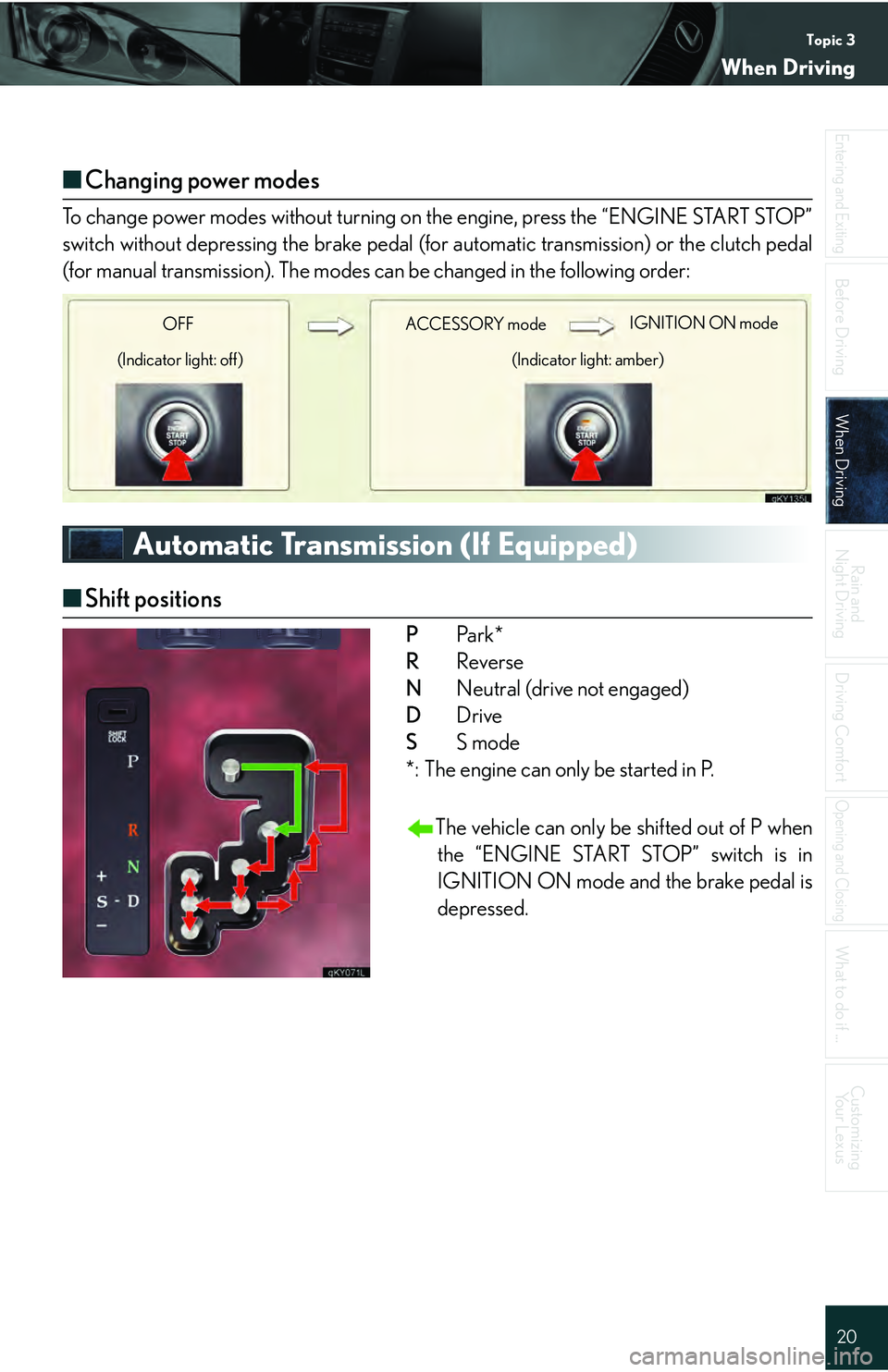
Topic 3
When Driving
20
Entering and Exiting
Before DrivingBefore Driving
When DrivingWhen Driving
Rain and
Night Driving
Driving Comfort
Opening and Closing
What to do if ...
Customizing Yo u r L e x u s
â– Changing power modes
To change power modes without turning on the engine, press the “ENGINE START STOP”
switch without depressing the brake pedal (for automatic transmission) or the clutch pedal
(for manual transmission). The modes can be changed in the following order:
Automatic Transmission (If Equipped)
â– Shift positions
P Pa r k *
R Reverse
N Neutral (drive not engaged)
D Drive
S S mode
*: The engine can only be started in P.
The vehicle can only be shifted out of P whenthe “ENGINE START STOP” switch is in
IGNITION ON mode and the brake pedal is
depressed.
ACCE SSORY mode IGNITION ON mode
(Indicator light: amber)
OFF
(Indicator light: off)
Page 23 of 66
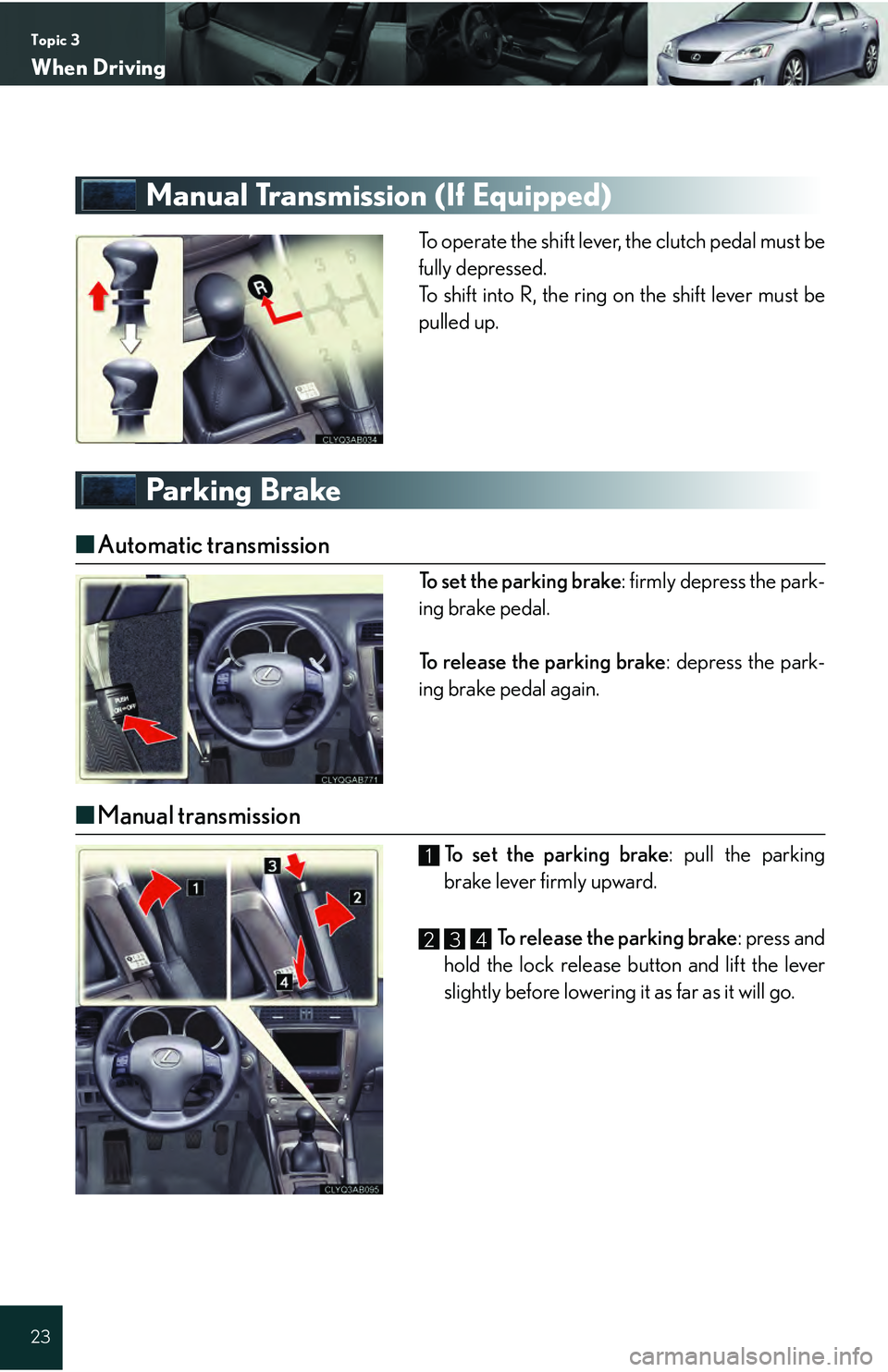
Topic 3
When Driving
23
Manual Transmission (If Equipped)
To operate the shift lever, the clutch pedal must be
fully depressed.
To shift into R, the ring on the shift lever must be
pulled up.
Parking Brake
â– Automatic transmission
To set the parking brake : firmly depress the park-
ing brake pedal.
To release the parking brake : depress the park-
ing brake pedal again.
â– Manual transmission
To set the parking brake : pull the parking
brake lever firmly upward.
To release the parking brake: press and
hold the lock release button and lift the lever
slightly before lowering it as far as it will go.1
234
Page 57 of 66

What to do if ...
57
List of Warning/Indicator Lights
The units used on the speedometer, the tachometer gauge display, indicators and warning
lights may differ depending on the model / type.
Stop the vehicle immediately. Continuing to drive the vehicle may be dangerous.
(U.S.A.)
(Canada)Brake system warning light
Stop the vehicle immediately.
Charging system warning light
Have the vehicle inspected immediately.
(U.S.A.)
(Canada)Malfunction
indicator lamp
Electric power steering
warning light
Pre-collision system
warning light*1
SRS warning light
(U.S.A.)
(Canada)ABS warning light
For further information, refer to the Owner's Manual.
Page 60 of 66

60
Entering and Exiting
Before Driving
When Driving
Rain and
Night Driving
Driving Comfort
Opening and Closing
What to do if ...
Customizing Yo u r L e x u s
If the electronic key does not operate
properly
â– Unlocking and locking the doors
To unlock or lock the vehicle, use the mechanical
key to remove the lock cover on the driver's door
handle. The mechanical key is stored inside the
electronic key.
Unlocks
Locks
â– Starting the engine
Depress the brake pedal (for automatic trans-
mission) or clutch pedal (for manual transmis-
sion).
Touch the Lexus emblem side of the electronic
key to the “ENGINE START STOP” switch.
Press the “ENGINE START STOP” switch
within 10 seconds of the buzzer, keeping the
brake pedal (for automatic transmission) or
clutch pedal (for manual transmission)
depressed.
1
2
If the electronic key battery becomes depleted, replace it with a new battery. For instruc-
tions on replacing the battery, refer to the Ow ner's Manual. If you need further assistance,
contact your Lexus dealer.
Page 61 of 66

What to do if ...
61
If the engine doesn't start
Make sure that the correct operating procedures have been followed.Make sure that the brake pedal (for automatic
transmission) or clutch pedal (for manual trans-
mission) is firmly depressed when attempting to
start the engine. (ď‚®P.1 9 )
Automatic transmission
Manual transmission
Make sure that the steering wheel lock is released.
To release the steering wheel lock, gently turn the
wheel left or right while pressing the “ENGINE
START STOP” switch. (P.9 )
Brake/clutch pedal
Steering wheel lock
If the engine still does not st art, see the Owner's Manual fo r more information or contact
your Lexus dealer.